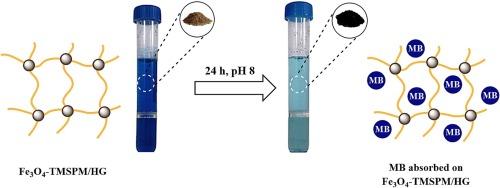Preparation of nanocomposite hydrogel based on Fe3O4-TMSPM/poly(HEMA-PEG6MA-IA) for the removal of methylene blue dye from aqueous solution
IF 2.5
Q2 CHEMISTRY, MULTIDISCIPLINARY
引用次数: 0
Abstract
In this work, a new hydrogel poly(2-hydroxyethyl methacrylate-co-polyethylene glycol methacrylate-co-itaconic acid) poly(HEMA-PEG6MA-IA) covalently crosslinked with Fe3O4 nanoparticles functionalized with 3-(trimethoxysilyl)propyl methacrylate organosilane (TMSPM) was prepared by free radicals, named Fe3O4-TMSPM/HG. FTIR-ATR, TGA, XRD, and TEM experiments were utilized to explore the Fe3O4-TMSPM/HG nanocomposite hydrogel. Swelling studies were also carried out in water, in different pH media, and then used in the adsorption of the cationic dye methylene blue (MB) from aqueous media. The factors controlling the adsorption process such as pH, dose, contact time, initial MB concentration, and temperature were investigated. The maximum MB adsorption capacity (270.27 mg/g) using Fe3O4-TMSPM/HG was obtained under the best conditions pH 8, dose 0.5 mg/mL, contact time 24 h, and ambient laboratory temperature (≈15 °C). The kinetic and isothermal experiments showed that the adsorption of MB followed the pseudo-second-order and Langmuir models. The effect of temperature on the adsorption capacity is related to the swelling, since the Fe3O4-TMSPM/HG nanocomposite hydrogel exhibit temperature-responsive. After 5 adsorption–desorption cycles, the adsorption decreased by 19 mg/g compared to the initial adsorption capacity. All the experimental results show that the prepared Fe3O4-TMSPM/HG nanocomposite hydrogel has the potential to be applied as an adsorbent for MB dye.

制备基于 Fe3O4-TMSPM/poly(HEMA-PEG6MA-IA) 的纳米复合水凝胶以去除水溶液中的亚甲基蓝染料
本研究采用自由基法制备了一种新型聚(2-羟乙基甲基丙烯酸酯-聚乙二醇甲基丙烯酸酯-衣康酸)聚(HEMA-PEG6MA-IA)水凝胶,该水凝胶与由 3-(三甲氧基硅基)丙基甲基丙烯酸酯有机硅烷(TMSPM)功能化的 Fe3O4 纳米粒子共价交联,命名为 Fe3O4-TMSPM/HG。利用 FTIR-ATR、TGA、XRD 和 TEM 实验对 Fe3O4-TMSPM/HG 纳米复合水凝胶进行了研究。还在水中和不同 pH 值的介质中进行了溶胀研究,然后用于吸附水介质中的阳离子染料亚甲基蓝(MB)。研究了控制吸附过程的因素,如 pH 值、剂量、接触时间、甲基溴初始浓度和温度。在 pH 值为 8、剂量为 0.5 mg/mL、接触时间为 24 h 和实验室环境温度(≈15 °C)的最佳条件下,Fe3O4-TMSPM/HG 获得了最大的甲基溴吸附容量(270.27 mg/g)。动力学和等温实验表明,甲基溴的吸附遵循伪二阶和朗缪尔模型。温度对吸附容量的影响与溶胀有关,因为 Fe3O4-TMSPM/HG 纳米复合水凝胶具有温度响应性。经过 5 次吸附-解吸循环后,吸附量比初始吸附量减少了 19 毫克/克。所有实验结果表明,制备的 Fe3O4-TMSPM/HG 纳米复合水凝胶具有作为 MB 染料吸附剂的潜力。
本文章由计算机程序翻译,如有差异,请以英文原文为准。
求助全文
约1分钟内获得全文
求助全文

 求助内容:
求助内容: 应助结果提醒方式:
应助结果提醒方式:


